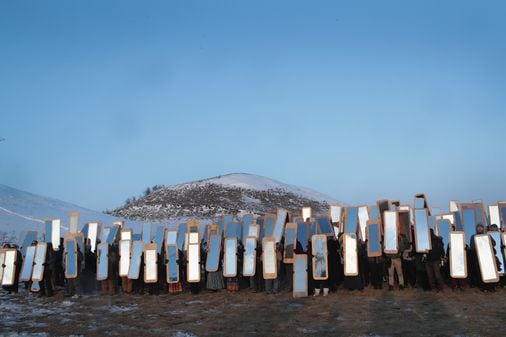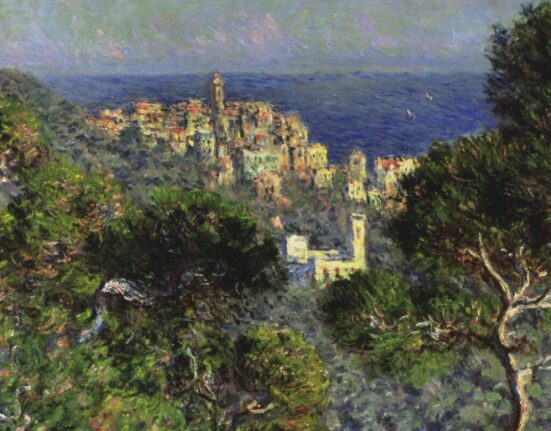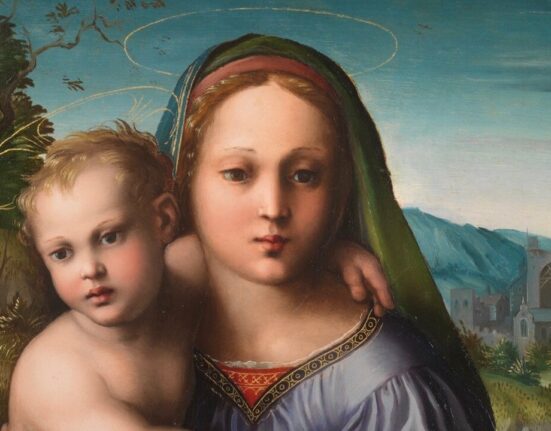
In recent years, the “Mirror Shield Project” has become something more, too. It’s been shown at museums at least a dozen times — I’ve seen it at the Peabody Essex Museum in Salem, in two different shows; and at the Metropolitan Museum of Art in New York. The piece is also on view now at Bard College’s Hessel Museum of Art in upstate New York in an exhibition of Native American performance and activism that closes Nov. 26. Is it too soon to call it totemic? I’m not sure. But it’s one of those rare works that a canon can be built with, a galvanizing piece that fires the imagination about what art can do.
“The Land Carries Our Ancestors,” curated by the Salish-Kootenai artist Jaune Quick-To-See Smith, feels full of such works, which makes it a landmark in all kinds of ways. The art world has been spotty at best in making space for contemporary Indigenous art. With nearly 50 artists, Smith’s show is the first major contemporary Indigenous survey exhibition at the gallery in 70 years, and the clearest signal so far of a broad shift, long overdue.

A visible emblem of that shift, the artist Jeffrey Gibson, who is Choctaw-Cherokee, was selected to represent the United States at next year’s Venice Biennale, the contemporary art world’s most significant and prestigious event. Smith herself had a career retrospective at the Whitney Museum of American Art earlier this year. But there are signs everywhere, and notably in New England. The Museum of Fine Arts has slipped Native American art into collection displays, where Norval Morrisseau, who was Anishinaabe, and Preston Singletary, who is Tlingit, share space with American giants like Georgia O’Keeffe and Arthur Dove. The museum also just opened an exhibition of contemporary Indigenous prints, signaling a growing area of its collection. In the recently re-installed permanent collection at the Portland Museum of Art, contemporary Indigenous worldviews infuse the analysis of work by American icons such as Winslow Homer and Albert Bierstadt.
At Colby College, an exhibition centered on early-20th-century paintings of Native Americans by white artists who relocated to New Mexico is deepened with responses by contemporary Pueblo artists eager to rewrite those histories and speak for themselves. Back in Boston, Tufts University Art Galleries are hosting two exhibitions with of-the-moment concerns. “Vexoa: We Know,” at their Medford gallery, showcases Indigenous artists from Brazil as they grapple with the dire threat of development of the Amazon rain forest. At Tufts’s downtown campus in the Fenway, Elizabeth James Perry, an enrolled member of the Aquinnah Wampanoag tribe on Martha’s Vineyard, this fall crafted a paean to the natural world with delicate weaving and jewelry work built from materials close at hand near her home.

An accelerating climate emergency makes a disturbingly apt backdrop for contemporary Indigenous art. In Washington, Smith’s exhibition is explicitly about Native American stewardship and spiritual connections to the land, regardless of geography and tribal affiliation. Built into that is an indictment, and a lament, for colonialism’s violent severing of those connections, and how the natural world has been under increasing threat from post-colonial profiteering.
Luger’s work is an obvious example, but there are more subtle gestures, too. The rich, blue haze of Diné painter Emmi Whitehorse’s “Fog Bank,” 2020, with delicate flotsam adrift stirs notions of infection, impurity, contamination. Will Wilson’s lush, silvery photographic panorama of a view from atop a Southwestern mesa reverses the conventional notion of a sublime landscape with an urgent modern anxiety. He calls it “Auto-Immune Response no. 2,” one of a series of apocalyptic visions of a future where his ancestral Diné lands are little more than a beautiful corpse, toxified beyond repair. The figures in the foreground are gas-masked against the danger.

In the midst of “Mirror Shield Project,” you can see a new canon taking shape. Rose B. Simpson’s “Tontanzin,” 2021, is here, a sinister, earthly effigy of a maternal goddess in the ruddy orange clay of the Southwest. The Santa Clara Pueblo artist’s recent appearances at Mass MoCA, the MFA and the Institute of Contemporary Art Boston have made her all but a fixture around here, not to mention beyond. Seneca artist Marie Watt’s collaborative soft sculptures have brought notions of community and care to PEM and 18 other American art museums this year alone. At the National Gallery, “Antipodes,” 2020, her glass bead quilts juxtapose the terms “Skywalker” and “Skyscraper,” the latter famously built by the former, Indigenous ironworkers laboring hundreds of feet above Manhattan in the early 20th century. And of course, Gibson, whose 2020 beaded punching bag sculpture here — “To Feel Myself Beloved on the Earth,” it reads, in red boldface against a geometric pattern — feels like an invitation to release built-up frustration from the litany of affronts to the natural world. (Gibson’s solo exhibition at the deCordova in Lincoln was a highlight of 2021.)

In an expansive grid of dozens of smaller photographic pieces and works on paper, Smith deploys an array of strategies, media, and concerns that makes the breadth of contemporary Indigenous practice both obvious and wildly engaging. Wendy Red Star, who is Apsáalooke, is here (and also in collections at the MFA and PEM) with “The (HUD),” 2010, a print of a stack of modular housing, the likes of which the federal Housing and Urban Development agency threw together on reservations like hers, the Crow reservation in Montana. It contrasts with the delicate untitled 2021 abstraction of Luzene Hill, who is Cherokee; an earthy stain of ink, charcoal, tea, and gouache, it coaxes forth a fragile imprint of distress with the elemental presence of the planet itself.
What’s not here is as important as what is. A subtle undercurrent of the display is its checkerboard pattern, an echo of the 1887 federal Dawes Act, which carved out tracts of Indigenous land for settlers and interspersed them with their new Native neighbors.
The encroachment was at least partly designed to fracture Native communities, which it surely did. The way back remains long and filled with bureaucratic snafus, but Native communities are putting the pieces back together as never before. Given the looming environmental disasters, we should all hope so.

Diné artist Stephen Yazzie’s “Orchestrating a Blooming Desert,” 2003, a vivid painting of an Indigenous man conducting the blossoming of myriad life amid the arid landscape, is a little on-the-nose, conceptually; but please, take his point: It’s about the land, who knows it, and who can care for it best.
Can these ideas, finally, truly break through? The good news is they already have, and well outside the art world bubble. Prominent think tanks like The Wilson Center have brought forward Indigenous strategies in the battle against climate change, and the 2021 Glasgow Climate Summit featured the work of Indigenous activists deep in the fight, too.
Official American history and culture — written and defined, as ever, by the victors — has suppressed, quelled, or disregarded Indigenous knowledge and culture for centuries. Amid what feels like a genuine resurgence, let’s hope it will be different this time.
THE LAND CARRIES OUR ANCESTORS: Contemporary Art by Native Americans
At National Gallery of Art, East Building, 4th St. NW, Washington, D.C. Through Jan. 15. 202-737-4215, www.nga.gov
Murray Whyte can be reached at murray.whyte@globe.com. Follow him @TheMurrayWhyte.







